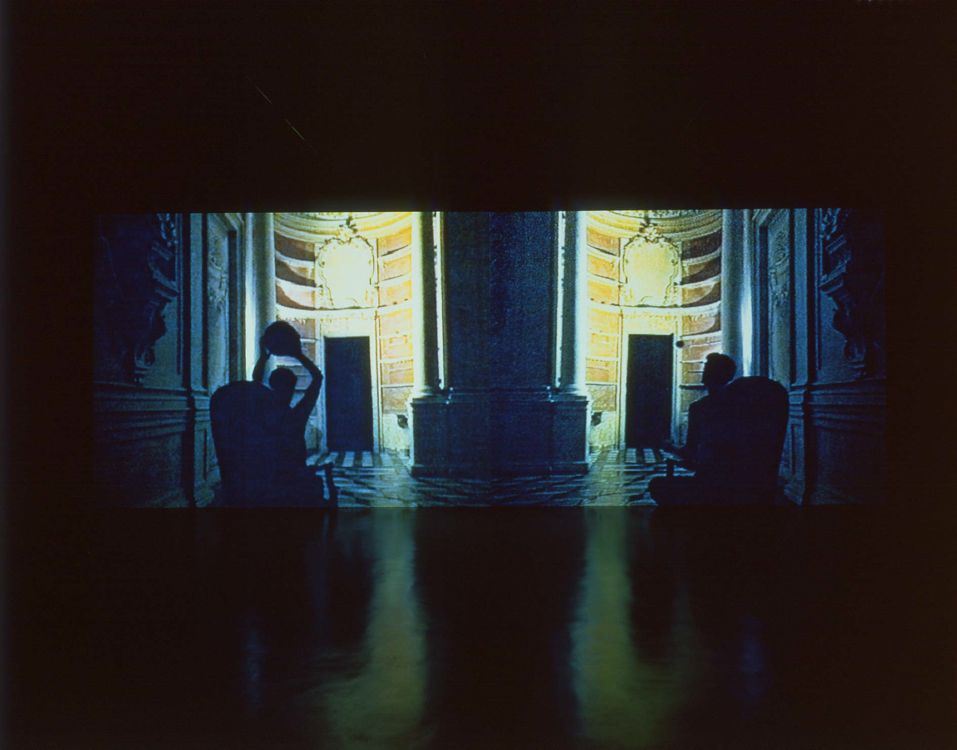Grazia Toderi
Choosing video as her medium, Grazia Toderi heightens its more immaterial aspect, giving her images an atemporal presence usually reserved for paintings. In her early works, the artist focused on the repetitiousness of domestic details, but her viewpoint seems to gradually move from a vision immersed in the world to one located above it. Views of stadiums, arenas, and theaters, along with panoramic aerial views of cities, become the object of an investigation that seeks to transcend human finiteness. In several works, Toderi joins an intimate view grounded in individual memory with a fantastical dimension that alludes to the collective imaginary constructed through the mass media. Since the early 1990s, the artist has preferred to use a fixed video camera and has structured her videos as continuous loop projections.
L’atrio (The Atrium), 1998, is one of the video-projections that stemmed from Toderi’s encounter with the spaces of the Castello di Rivoli on the occasion of her solo exhibition. Like a stately royal portrait, the work is a diptych whose symmetrical construction frames, from behind, a female and a male figure, both turned toward a dark threshold. The title refers to the original function of the room where the video was made, the so-called “Room of Bacchus and Ariadne,” conceived by Juvarra as a link between the apartments of the king and those of the queen. In a lively rhythm of action and repose, the two figures throw, respectively, a ball and some spheres. The female figure tosses the ball across the door that extends the space of the image, in contrast to the geometric orbits delineated by small spheres skillfully juggled by the male figure. Even in their similarity, the two images of the diptych, engaged in play, test different spaces and physical laws.
The television recording of the World Cup soccer final in the Paris stadium in 1998 is the point of departure for her video projection Il decollo (The Take-Off), 1998. Manipulating the original image, Toderi accentuates the play of lights that illuminates the nocturnal spectacle and gives a sense of rotation to the elliptical form of the stadium, transforming it into a sort of spaceship. Moreover by enhancing the television recording’s view from above, Toderi offers a privileged viewpoint, removed from the contingency of events, while the sound conveys the intense emotions of a far-away crowd. The work is the first in a major series she made, inspired by stadiums.
Extending her investigations to places that define community, the artist turned her attention to the architecture of the theater, particularly to the Italian typology of the “beehive-style” theater. The video Spettatori (Audience), 2000, filmed at the Municipal Theater at Casale Monferrato, belongs to this series of works. Through digital manipulations, the theater becomes filled with the public and animated by lively murmuring. The audience evoked in the title—the protagonist in the ritual of seeing and being seen—is rendered as a luminous presence, captured by the ceaseless spectacle provided by the celestial vault. Looking out into cosmic space, this piece is an homage to the spaceship in 2001: A Space Odyssey, the famous film by Stanley Kubrick.
Interested in the different geometries that regulate sports and the spaces to which they are assigned, in 2001 Toderi went to the United States as the winner of a Fellowship for Young Italian Artists of the Supporting Friends of Castello di Rivoli. Delving into American culture, in particular what the artist saw as its interest in entertainment and sports as tools of power and affirmation on the international stage, she created several works, including Subway Series, 2001. The title corresponds to the term commonly used to indicate championship matches between the two baseball teams located in New York, a reference to the fact that the two principal stadiums, Yankee Stadium and Shea Stadium, are easily reachable by subway. The work is made up of four video projections in which Toderi emphasizes the particular geometry of these sports venues, abstracting them into symbolic forms related to the perpetual interweaving of a triangular and a circular shape.
[MB]



